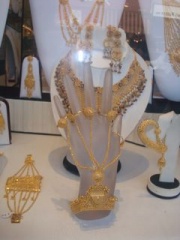From The Peopling of New York City
Dress and Jewelry Defining South Asian Women
Ideals of feminine beauty and marriage (via young eligible brides) are displayed on every street. The ethnic clothing, glittered and made of bright synthetic fabrics, is quite traditional; however, is embraced by contemporary South Asian women and second generation women as well. Commonly, when South Asians gather on holidays, weddings, family/friend events, or even at school's multicultural assemblies, this dress is worn by women of all ages. Some educated woman will sometimes wear their Sari's to work once in a while. Ms. Subramaniam, a chemistry teacher and HIV/AID Researcher, is usually dressed in professional clothing (business suits, pants, dress shirts) but comes he school workplace sometimes with a rich, red sari, a bindi on her forehead, and gold bangles on her wrists to embrace her culture. Besides teaching chemistry, she runs the school's Desi Club.
Women especially are proud to wear their lavish South Asian culture and are great participant in cultural events in New York. Overall, it seems that women uphold ethnic traditions, in religion and custom, more then men do. It is quite rare to see a man dressed in a traditional Indian tunic on the streets of Jackson Heights. Furthermore, women uphold aspects of culture through food, dance and prayer. At The Ganesha Temple in Flushing, Queens, I watched an elderly woman in a ginger sari, eyes overflowing with emotion and love, spin slowly three times, bow to the god, and then walk around the shrine. However, contrastingly, a pair of Indian men dressed in leather jackets and slacks walked in briefly, performed a hand gesture, and left after five minutes. This of course is a generalization, since there are many devout men at the temple. However, proportionally, more women appeared at the temple. (The Ganesha Temple in Flushing) I believe woman uphold their "South Asian-ness," especially via dress and jewelry on ritual occasion, to perhaps better assert themselves and represent themselves. Women, who were less represented in the work force in the past, have had to embrace in culture and ritual to occupy and enrich their lives. These traditions have crossed over and remained as an integral part of the lives of woman. Woman have been able to develop their traditions more substantially because of their important traditional roles as homemakers and nurturer that have stayed with them.

